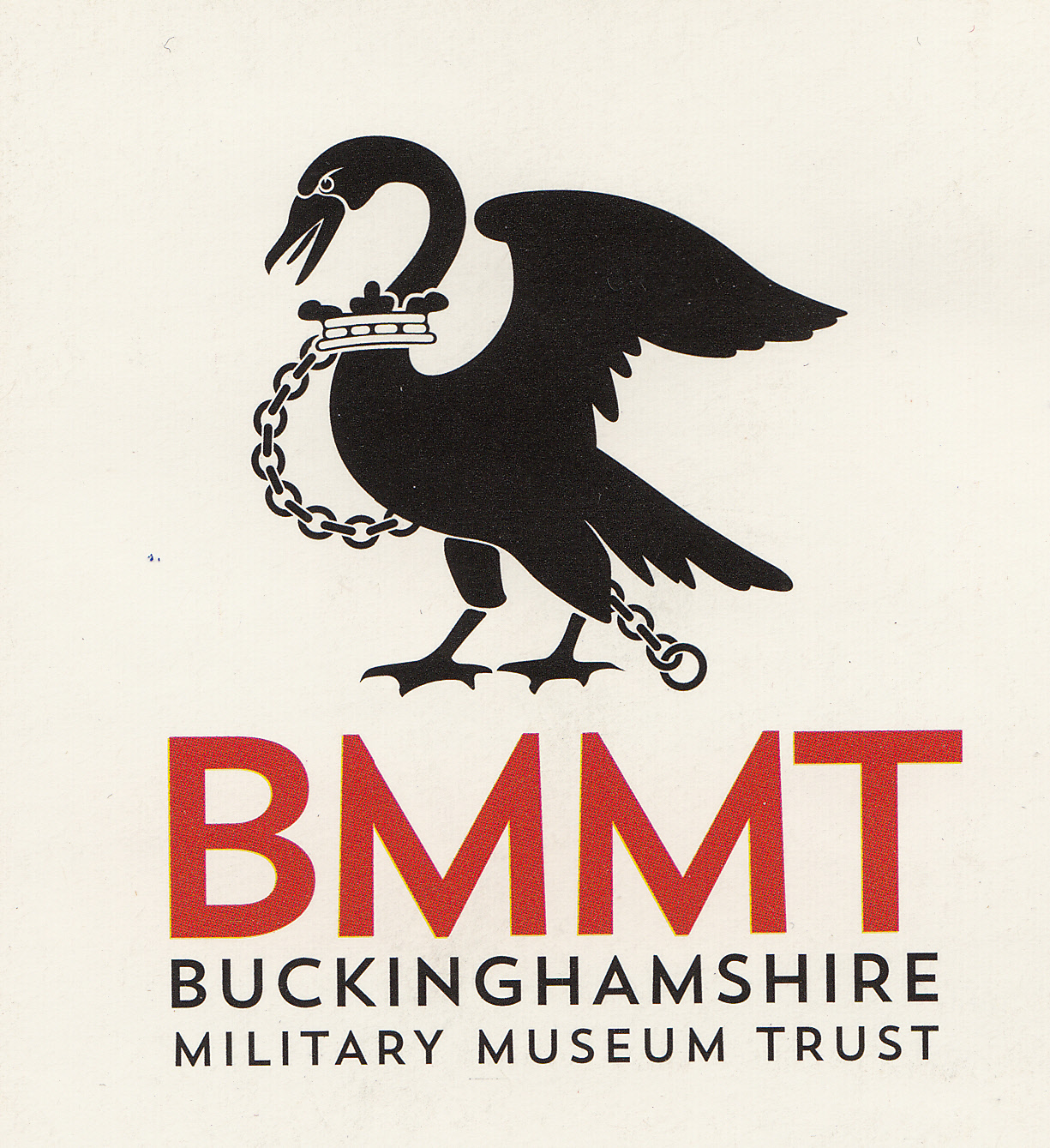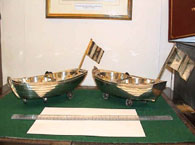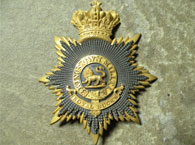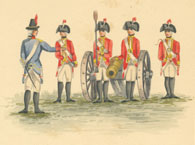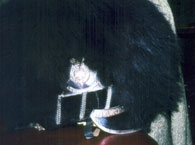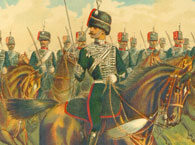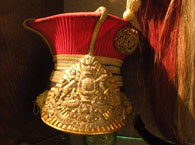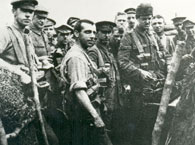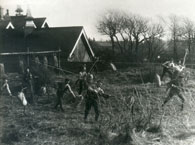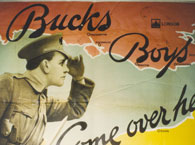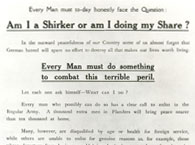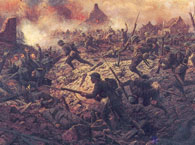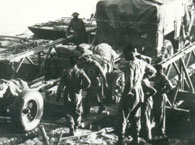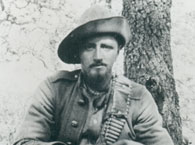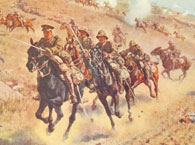The Royal Bucks King’s Own Militia
Dating back to the Anglo-Saxon period, the militia was first organised systematically in the mid 1500s, and existed until abolished in 1908.
Between 1757 and 1831 the militia was raised by compulsory ballot. The titles of ‘Royal’ and ‘King’s Own’ were given the regiment for guarding King George III whilst he was bathing at Weymouth in 1794. The Royal Bucks saw service in Ireland in both 1798 and 1813, and in occupation of Bordeaux in 1814. It was in Ireland again during the South African War in 1900.
The Royal Bucks Yeomanry and Royal Bucks Hussars
First raised in 1794 during the French Revolutionary Wars, there were three regiments of mounted yeomanry by 1803.
Two of these regiments were disbanded in 1827, but the 2nd or Mid Bucks Regiment of Yeomanry survived, receiving its ‘Royal’ title from Queen Victoria in 1845. It became the Royal Bucks Hussars in 1889 and some men served in the South African War as part of the Imperial Yeomanry. The yeomanry became the mounted arm of the Territorial Force in 1908, and the 1st Royal Bucks Hussars served at Gallipoli and in Palestine in the First World War. Converted to field artillery, the regiment served in France and Burma during the Second World War as 99th (Royal Bucks Yeomanry) Field Regiment, RA.
The Bucks Volunteers and Rifle Volunteers
Raised in 1797, the infantry volunteers were mostly replaced by a semi-balloted force known as the Local Militia in 1808.
All disappeared in 1815 at the end of the Napoleonic Wars, but new volunteer infantry units known as rifle volunteers were formed in a French invasion scare in 1859. Bucks rifle volunteers served in a special service company in the South African War, the volunteer force as a whole being absorbed in the Territorials in 1908.
The Bucks Battalions
With the abolition of the Royal Bucks King’s Own Militia in 1908, there was successful public pressure to rename the regular Oxfordshire Light Infantry, the Oxfordshire and Buckinghamshire Light Infantry and to name the new Territorial infantry battalion in the county as the Buckinghamshire Battalion.
The 1st and 2nd Bucks Battalions saw active service during the First World War, the 1st serving in France and Italy, and the 2nd in France, where it took heavy casualties at Fromelles in July 1916. In the Second World War the 1st Bucks Battalion gallantry defended Hazebrouck during the retreat to Dunkirk in May 1940 and, reconstituted, acted as part of a Beach Group on SWORD Beach during the Normandy landings in June 1944 and then as ‘T’ (Target) Force seizing important German research installations.
The Bucks Volunteer Training Corps, and the Bucks Home Guard
In both world wars, with the Territorials as well as the regular army abroad, new volunteer units were raised in the face of possible German invasion.
During the First World War, they were known as the Volunteer Training Corps, Bucks raising three battalions. In May 1940 came the famous appeal for Local Defence Volunteers, renamed the Home Guard in July 1940. Bucks raised 13 battalions, duties including guarding important locations such as Bletchley Park, Chequers, and the HQ of Bomber Command at High Wycombe.
Bucks Citizen/Volunteer Soldiers at War
The 1st Bucks Battalion
- France and Flanders, 1915-17
- Italy, 1917-18
- France and Flanders, 1940
- North West Europe, 1944-45 (as No 6 Beach Group, and T (Target) Force)
Noted Actions:
- Pozières, Somme, 21-24 July 1916
- St Julien, Ypres, 16 August 1917
- Hazebrouck, France, 27-28 May 1940
- D Day, Normandy, 6 June 1944
The 2nd Bucks Battalion
- France and Flanders, 1915-18
- Northern Ireland, 1940-43
- Noted Actions:
- Fromelles, Somme, 19 July 1916
- Wieltje, Ypres 22 August 1917
The Royal Bucks King’s
Own Militia
- Ireland 1798, 1813, 1900-02
The Bucks Rifle Volunteers
- South Africa, 1900-1901 (as part of the Volunteer Service Company attached to the 1st Oxfordshire Light Infantry)
The Royal Bucks Hussars/ Royal Bucks Yeomanry
- South Africa, 1900-1901 (as the 37th, 38th, 56th and 57th Companies, Imperial Yeomanry)
- Gallipoli, 1915
- Western Desert, 1915-16
- Palestine, 1916-18
- France, 1918 (as part of 101st (Bucks and Berks) Battalion, Machine Gun Corps)
- France, 1940 (as 99th (RBY) Field Regiment, RA)
- Burma, 1942-45 (as 99th (RBY) Field Regiment, RA)
Noted Actions:
- Boshof, South Africa, 5 April 1900 (57th and 58th Companies, IY)
- Chocolate Hill, Gallipoli, 21-22 August 1915
- El Mughar, Palestine, 13 November 1917
- Abu Shusha, Palestine, 15 November 1917
- Kohima, Burma 18 April –7 June 1944
Reserve Collections
The Trust’s documents and photographs are all held by the Buckinghamshire Archives at Aylesbury and are available during its normal opening hours.
Those uniforms and artefacts not displayed at Buckingham are held in the Resource Centre of the Bucks County Museum at Halton. They may be viewed Monday to Friday 1000-1700 by appointment with the Bucks County Museum. Tel: 01296 624519 or email museum@buckscountymuseum.org
This website of The Buckinghamshire Military Museum Trust ('BMMT') is copyright of BMMT. If any items on the site are republished or copied for research private study or for use within educational establishments the source and copyright status must be acknowledged and any reference quoted. Commercial users wishing to reproduce any item must seek prior written permission from the Trustees.
BMMT has taken all reasonable steps to ascertain any known copyrights. Any infringement is inadvertent and will be rectified on notification.
